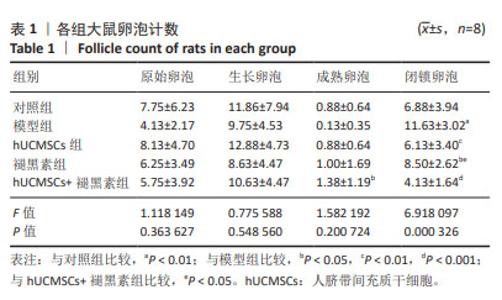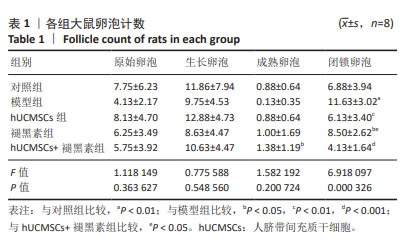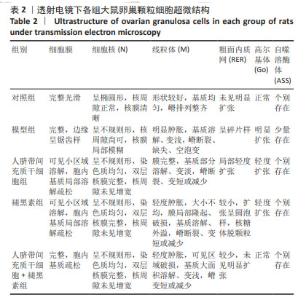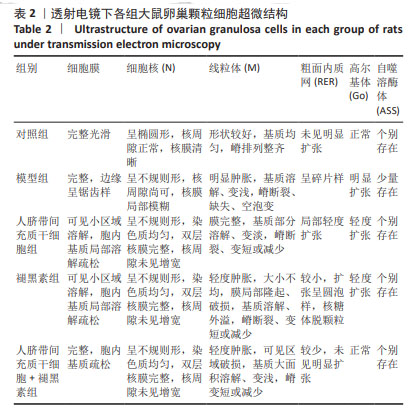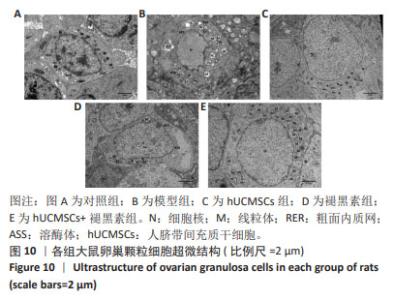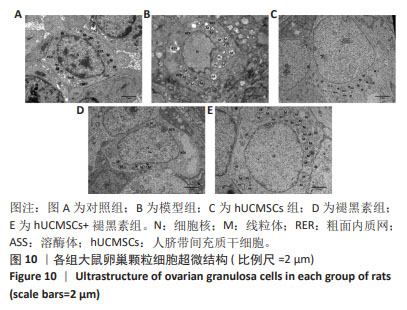Chinese Journal of Tissue Engineering Research ›› 2025, Vol. 29 ›› Issue (25): 5281-5288.doi: 10.12307/2025.518
Therapeutic effects and mechanism of human umbilical cord mesenchymal stem cells combined with melatonin on premature ovarian insufficiency induced by chemotherapy
Wei Luxiao1, 2, 3, Huang Bingxue1, 2, Du Jing1, 2, 3, Shi Shuanxia1, 2, Wang Jitian1, 2, Wang Ling1
- 1Reproductive Medicine Center, 3Key Laboratory of Stem Cells and Gene Drugs of Gansu Province, 940 Hospital of Joint Logistics Support Force of Chinese PLA, Lanzhou 730000, Gansu Province, China; 2First Clinical Medical College of Gansu University of Chinese Medicine, Lanzhou 730000, Gansu Province, China
-
Received:2024-04-10Accepted:2024-06-01Online:2025-09-08Published:2024-12-14 -
Contact:Wang Ling, Chief physician, Reproductive Medicine Center, 940 Hospital of Joint Logistics Support Force of Chinese PLA, Lanzhou 730000, Gansu Province, China -
About author:Wei Luxiao, Master candidate, Reproductive Medicine Center, and Key Laboratory of Stem Cells and Gene Drugs of Gansu Province, 940 Hospital of Joint Logistics Support Force of Chinese PLA, Lanzhou 730000, Gansu Province, China; First Clinical Medical College of Gansu University of Chinese Medicine, Lanzhou 730000, Gansu Province, China -
Supported by:Military Logistics Research Project, No. 2023HQZZ-04 (to WL); Gansu Natural Science Foundation, No. 22JR11RA010 (to WL); Lanzhou Science and Technology Plan Project, No. 2023-ZD-182 (to WL)
CLC Number:
Cite this article
Wei Luxiao, Huang Bingxue, Du Jing, Shi Shuanxia, Wang Jitian, Wang Ling. Therapeutic effects and mechanism of human umbilical cord mesenchymal stem cells combined with melatonin on premature ovarian insufficiency induced by chemotherapy[J]. Chinese Journal of Tissue Engineering Research, 2025, 29(25): 5281-5288.
share this article
Add to citation manager EndNote|Reference Manager|ProCite|BibTeX|RefWorks
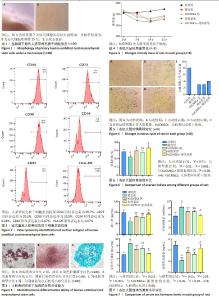
2.1 人脐带间充质干细胞的分离培养、鉴定和诱导分化结果 组织贴壁法分离培养至第7天可见贴壁梭形细胞从组织周围爬出,生长状态良好,见图1A,约15 d时组织周围细胞生长达80%以上,见图1B。第3代人脐带间充质干细胞表面抗原CD44、CD73、CD90阳性表达,CD34、CD45、HLA-DR阴性表达,符合国际细胞治疗协会提出的间充质干细胞鉴定标准[13],说明实验分离培养所得细胞为人脐带间充质干细胞,见图2。成脂诱导分化2周后,显微镜下观察可见脂滴形成,油红O染色后脂滴呈红色,见图3A;成骨诱导分化3周后,显微镜下观察可见钙结节形成,茜素红染色后钙结节呈红色,见图3B;成软骨诱导分化3周后,可见直径约1 mm的软骨球形成,石蜡切片阿利新蓝染色呈蓝色,见图3C。 2.2 大鼠一般情况及动情周期变化 对照组大鼠随饲养时间的延长,体质量逐渐增加,精神、饮食、活动状态均无异常。其余组大鼠经过顺铂造模后,出现精神萎靡、进食水减少、活动减少、喜抱团、毛色发黄等情况,部分出现不同程度的腹泻,体质量逐渐下降,于造模第14天体质量达最低水平。经过治疗后,各治疗组大鼠精神好转,进食水及活动增加,毛色变白,体质量逐渐恢复,见图4。 性成熟大鼠动情周期为四五天,分为动情前期、动情期、动情后期和动情间期[14]。动情前期主要特征是大量圆形或椭圆形的有核细胞;动情期主要特征是大量不规则片状无核角化细胞;动情后期是动情期向动情间期的过渡,主要特征是有核细胞、无核角化细胞和白细胞同时存在;动情间期主要特征是大量白细胞和少量无核角化细胞[15],见图5。与对照组比较,模型组大鼠动情周期紊乱,表现为动情周期延长,停滞在动情间期或动情后期,部分大鼠阴道涂片时偶见血性分泌物。经过14 d治疗后,人脐带间充质干细胞组和褪黑素组动情周期正常大鼠占37.5%,人脐带间充质干细胞+褪黑素组动情周期正常大鼠占50%,而模型组无动情周期正常大鼠,表明人脐带间充质干细胞联合褪黑素治疗可使早发性卵巢功能不全大鼠动情周期恢复正常。 2.3 大鼠卵巢指数的变化 与对照组比较,模型组卵巢指数显著下降(P < 0.01);与模型组比较,各治疗组卵巢指数均显著增加(P < 0.01),其中人脐带间充质干细胞+褪黑素组差异更为显著(P < 0.001);与褪黑素组比较,人脐带间充质干细胞+褪黑素组卵巢指数增加更为明显(P < 0.05),表明人脐带间充质干细胞联合褪黑素治疗可明显改善卵巢萎缩,增加卵巢指数,见图6。 2.4 大鼠血清性激素水平的变化 与对照组比较,模型组雌二醇、抗缪勒管激素水平降低(P < 0.01),卵泡刺激素、促黄体生成素水平升高(P < 0.01);与模型组比较,各治疗组雌二醇、抗缪勒管激素水平均升高(P < 0.05),卵泡刺激素、促黄体生成素水平均降低(P < 0.05);与人脐带间充质干细胞组和褪黑素组比较,人脐带间充质干细胞+褪黑素组雌二醇、抗缪勒管激素水平升高更为明显(P < 0.05),卵泡刺激素、促黄体生成素水平降低更为明显(P < 0.05),表明人脐带间充质干细胞联合褪黑素治疗可明显改善大鼠卵巢的内分泌功能,见图7。"
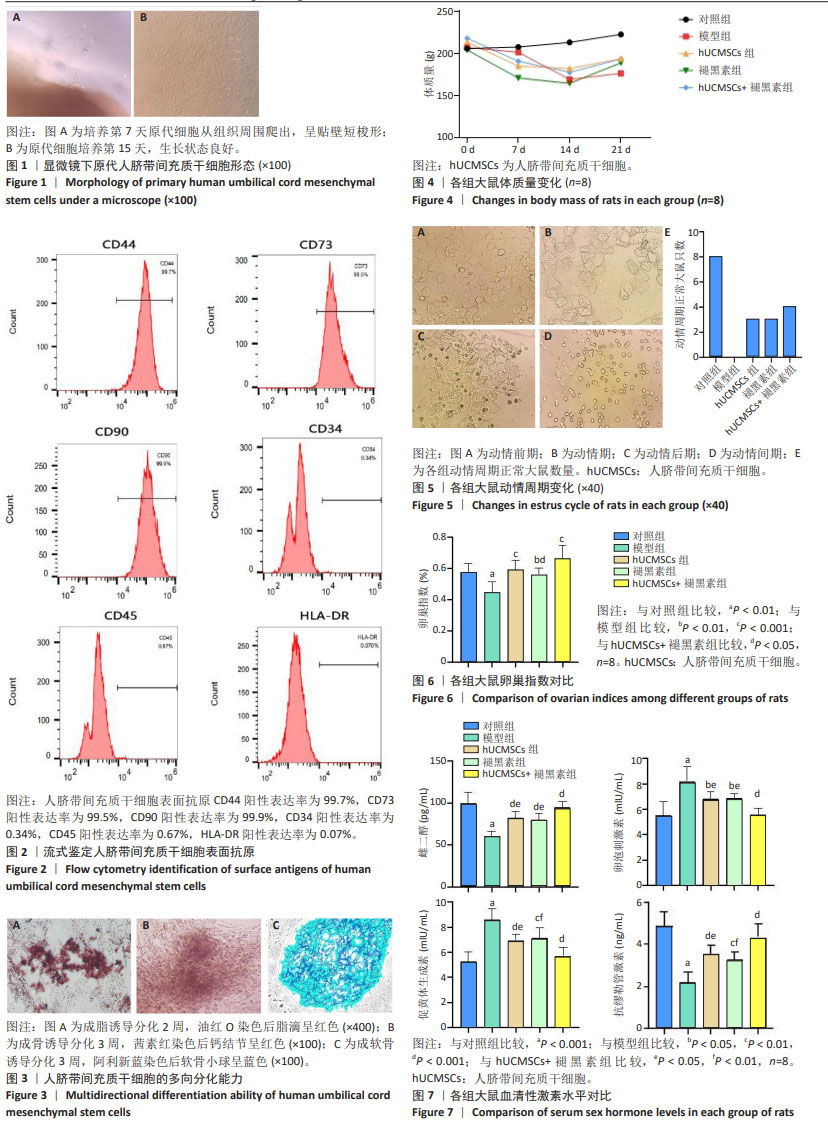

2.5 大鼠卵巢组织形态学变化及卵泡计数结果 与对照组比较,模型组卵母细胞溶解,透明袋塌陷,呈不规则状,闭锁卵泡显著增加(P < 0.01),原始卵泡、成熟卵泡和生长卵泡减少,但差异无显著性意义(P > 0.05),髓质中可见较多血管扩张充血,表明顺铂可破坏卵巢组织形态,改变各级卵泡的数量。与模型组比较,人脐带间充质干细胞+褪黑素组卵泡结构正常,闭锁卵泡显著减少(P < 0.001),成熟卵泡增加(P < 0.05),原始卵泡和生长卵泡增加,但差异无显著性意义(P > 0.05),髓质中血管未见明显异常;人脐带间充质干细胞+褪黑素组与人脐带间充质干细胞组比较,各级卵泡差异均无显著性意义(P > 0.05),髓质血管扩张充血明显减轻;与褪黑素组比较,人脐带间充质干细胞+褪黑素组闭锁卵泡减少更为明显(P < 0.05),表明人脐带间充质干细胞联合褪黑素治疗可改善卵巢组织学形态,减少闭锁卵泡,增加成熟卵泡,改善卵巢储备功能,见图8,9和表1。"
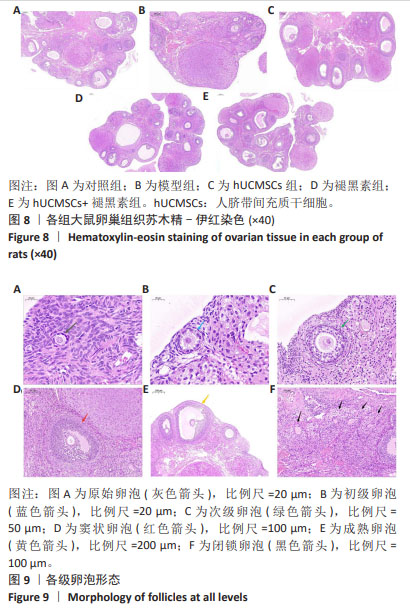
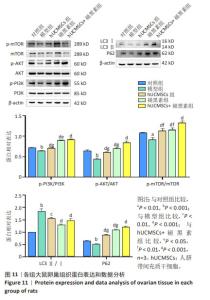
2.7 大鼠卵巢组织相关蛋白表达量的变化 与对照组比较,模型组p-PI3K/PI3K、p-AKT/AKT、p-mTOR/mTOR和P62蛋白表达量显著降低(P < 0.01),LC3Ⅱ/Ⅰ蛋白表达量显著升高(P < 0.001);与模型组比较,各治疗组p-PI3K/PI3K、p-AKT/AKT、p-mTOR/mTOR和P62蛋白表达量均显著升高(P < 0.001),LC3Ⅱ/Ⅰ蛋白表达量均显著降低(P < 0.01),其中人脐带间充质干细胞+褪黑素组差异更为显著(P < 0.001);与人脐带间充质干细胞组和褪黑素组比较,人脐带间充质干细胞+褪黑素组p-PI3K/PI3K、p-AKT/AKT、p-TOR/mTOR和P62蛋白表达量升高更为明显(P < 0.05),表明人脐带间充质干细胞联合褪黑素治疗早发性卵巢功能不全可能是通过上调PI3K/AKT/mTOR信号通路,抑制卵巢颗粒细胞自噬来改善化疗引起的卵巢功能损伤,见图11。"
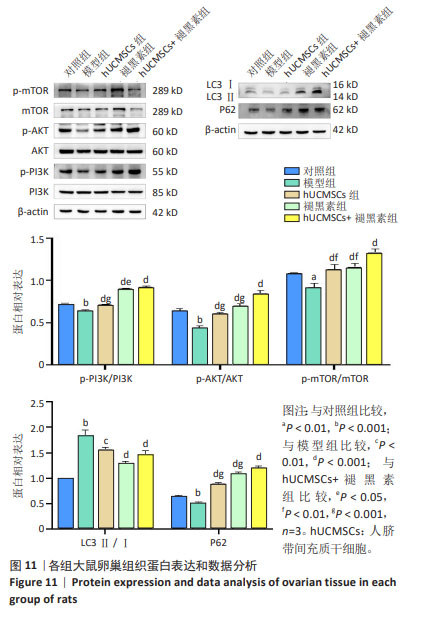
| [1] EUROPEAN SOCIETY FOR HUMAN REPRODUCTION AND EMBRYOLOGY (ESHRE) GUIDELINE GROUP ON POI; WEBBER L, DAVIES M, et al. ESHRE Guideline: management of women with premature ovarian insufficiency. Hum Reprod. 2016;31(5):926-937. [2] CHON SJ, UMAIR Z, YOON MS. Premature Ovarian Insufficiency: Past, Present, and Future. Front Cell Dev Biol. 2021;9:672890. [3] 吴结英,胡卫华.卵巢早衰的病因学研究进展[J].国际生殖健康/计划生育杂志,2019,38(4):332-336. [4] ZHANG C. The Roles of Different Stem Cells in Premature Ovarian Failure. Curr Stem Cell Res Ther. 2020;15(6):473-481. [5] SHEN J, CAO D, SUN JL. Ability of human umbilical cord mesenchymal stem cells to repair chemotherapy-induced premature ovarian failure. World J Stem Cells. 2020;12(4):277-287. [6] YAN L, WU Y, LI L, et al. Clinical analysis of human umbilical cord mesenchymal stem cell allotransplantation in patients with premature ovarian insufficiency. Cell Prolif. 2020;53(12):e12938. [7] ZHANG M, XIE T, DAI W, et al. Umbilical Cord Mesenchymal Stem Cells Ameliorate Premature Ovarian Insufficiency in Rats. Evid Based Complement Alternat Med. 2022;2022:9228456. [8] 刘晶晶,李宗阳,刘丽梅,等.褪黑素调控卵泡发育的研究进展[J].中国医学科学院学报,2023,45(6):997-1004. [9] XING F, WANG M, DING Z, et al. Protective Effect and Mechanism of Melatonin on Cisplatin-Induced Ovarian Damage in Mice. J Clin Med. 2022; 11(24):7383. [10] BARBERINO RS, MENEZES VG, RIBEIRO AEAS, et al. Melatonin protects against cisplatin-induced ovarian damage in mice via the MT1 receptor and antioxidant activity. Biol Reprod. 2017;96(6):1244-1255. [11] 张丽娟,陶仕英,赵丕文,等.顺铂建立大鼠卵巢早衰模型的实验研究[J].世界中医药,2015,10(10):1563-1565. [12] THAKUR M, FELDMAN G, PUSCHECK EE. Primary ovarian insufficiency in classic galactosemia: current understanding and future research opportunities. J Assist Reprod Genet. 2018;35(1):3-16. [13] CHOUDHERY MS, MAHMOOD R, HARRIS DT, et al. Minimum criteria for defining induced mesenchymal stem cells. Cell Biol Int. 2022;46(6):986-989. [14] AJAYI AF, AKHIGBE RE. Staging of the estrous cycle and induction of estrus in experimental rodents: an update. Fertil Res Pract. 2020;6:5. [15] CORA MC, KOOISTRA L, TRAVLOS G. Vaginal Cytology of the Laboratory Rat and Mouse: Review and Criteria for the Staging of the Estrous Cycle Using Stained Vaginal Smears. Toxicol Pathol. 2015;43(6):776-793. [16] SUNG H, FERLAY J, SIEGEL RL, et al. Global Cancer Statistics 2020: GLOBOCAN Estimates of Incidence and Mortality Worldwide for 36 Cancers in 185 Countries. CA Cancer J Clin. 2021;71(3):209-249. [17] BEDOSCHI G, NAVARRO PA, OKTAY K. Chemotherapy-induced damage to ovary: mechanisms and clinical impact. Future Oncol. 2016;12(20): 2333-2344. [18] GANESAN S, KEATING AF. The ovarian DNA damage repair response is induced prior to phosphoramide mustard-induced follicle depletion, and ataxia telangiectasia mutated inhibition prevents PM-induced follicle depletion. Toxicol Appl Pharmacol. 2016;292:65-74. [19] PETRILLO SK, DESMEULES P, TRUONG TQ, et al. Detection of DNA damage in oocytes of small ovarian follicles following phosphoramide mustard exposures of cultured rodent ovaries in vitro. Toxicol Appl Pharmacol. 2011;253(2):94-102. [20] TSAI-TURTON M, LUONG BT, TAN Y, et al. Cyclophosphamide-induced apoptosis in COV434 human granulosa cells involves oxidative stress and glutathione depletion. Toxicol Sci. 2007;98(1):216-230. [21] MADDEN JA, THOMAS PQ, KEATING AF. Phosphoramide mustard induces autophagy markers and mTOR inhibition prevents follicle loss due to phosphoramide mustard exposure. Reprod Toxicol. 2017;67:65-78. [22] JALALIE L, REZAEE MA, REZAIE MJ, et al. Human umbilical cord mesenchymal stem cells improve morphometric and histopathologic changes of cyclophosphamide-injured ovarian follicles in mouse model of premature ovarian failure. Acta Histochem. 2021;123(1):151658. [23] DENG T, HE J, YAO Q, et al. Human Umbilical Cord Mesenchymal Stem Cells Improve Ovarian Function in Chemotherapy-Induced Premature Ovarian Failure Mice Through Inhibiting Apoptosis and Inflammation via a Paracrine Mechanism. Reprod Sci. 2021;28(6):1718-1732. [24] LV X, GUAN C, LI Y, et al. Effects of single and multiple transplantations of human umbilical cord mesenchymal stem cells on the recovery of ovarian function in the treatment of premature ovarian failure in mice. J Ovarian Res. 2021;14(1):119. [25] 段卉妍,高琳英,张易葳.褪黑素在早发性卵巢功能不全中的应用及研究进展[J].中国医院药学杂志,2023,43(10):1165-1169. [26] AIERKEN A, LI B, LIU P, et al. Melatonin treatment improves human umbilical cord mesenchymal stem cell therapy in a mouse model of type II diabetes mellitus via the PI3K/AKT signaling pathway. Stem Cell Res Ther. 2022;13(1):164. [27] QIN W, WANG J, HU Q, et al. Melatonin-pretreated human umbilical cord mesenchymal stem cells improved endometrium regeneration and fertility recovery through macrophage immunomodulation in rats with intrauterine adhesions†. Biol Reprod. 2023;109(6):918-937. [28] 白俊.基于PI3K/AKT/mTOR信号通路研究补肾活血法调控大鼠卵巢颗粒细胞自噬的分子机制[D].成都:成都中医药大学,2018. [29] TIWARI M, PRASAD S, TRIPATHI A, et al. Apoptosis in mammalian oocytes: a review. Apoptosis. 2015;20(8):1019-1025. [30] CHOI JY, JO MW, LEE EY, et al. The role of autophagy in follicular development and atresia in rat granulosa cells. Fertil Steril. 2010;93(8):2532-2537. [31] BHARDWAJ JK, PALIWAL A, SARAF P, et al. Role of autophagy in follicular development and maintenance of primordial follicular pool in the ovary. J Cell Physiol. 2022;237(2):1157-1170. |
| [1] | Li Huayuan, Li Chun, Liu Junwei, Wang Ting, Li Long, Wu Yongli. Effect of warm acupuncture on PINK1/Parkin pathway in the skeletal muscle of rats with chronic fatigue syndrome [J]. Chinese Journal of Tissue Engineering Research, 2025, 29(8): 1618-1625. |
| [2] | Zhou Panpan, Cui Yinglin, Zhang Wentao, Wang Shurui, Chen Jiahui, Yang Tong . Role of cellular autophagy in cerebral ischemic injury and the regulatory mechanism of traditional Chinese medicine [J]. Chinese Journal of Tissue Engineering Research, 2025, 29(8): 1650-1658. |
| [3] | Zhu Hanmin, Wang Song, Xiao Wenlin, Zhang Wenjing, Zhou Xi, He Ye, Li Wei, . Mitophagy regulates bone metabolism [J]. Chinese Journal of Tissue Engineering Research, 2025, 29(8): 1676-1683. |
| [4] | Jin Kai, Tang Ting, Li Meile, Xie Yuan. Effects of conditioned medium and exosomes of human umbilical cord mesenchymal stem cells on proliferation, migration, invasion, and apoptosis of hepatocellular carcinoma cells [J]. Chinese Journal of Tissue Engineering Research, 2025, 29(7): 1350-1355. |
| [5] | Li Dijun, Jiu Jingwei, Liu Haifeng, Yan Lei, Li Songyan, Wang Bin. Three-dimensional gelatin microspheres loaded human umbilical cord mesenchymal stem cells for chronic tendinopathy repair [J]. Chinese Journal of Tissue Engineering Research, 2025, 29(7): 1356-1362. |
| [6] | Zhao Ruihua, Chen Sixian, Guo Yang, Shi Lei, Wu Chengjie, Wu Mao, Yang Guanglu, Zhang Haoheng, Ma Yong. Wen-Shen-Tong-Du Decoction promoting spinal cord injury repair in mice [J]. Chinese Journal of Tissue Engineering Research, 2025, 29(6): 1118-1126. |
| [7] | Zheng Rongfa, Mo Weibin, Huang Peng, Chen Junji, Liang Ting, Zi Fangyu, Li Guofeng. Effects of electroacupuncture on the expression of metabolic enzymes and autophagy genes in gastrocnemius muscle tissues of exercising rats [J]. Chinese Journal of Tissue Engineering Research, 2025, 29(6): 1127-1136. |
| [8] | Chen Yuning, Jiang Ying, Liao Xiangyu, Chen Qiongjun, Xiong Liang, Liu Yue, Liu Tong. Buqi Huoxue Compounds intervene with the expression of related factors and autophagy related proteins in a rat model of cerebral ischemia/reperfusion [J]. Chinese Journal of Tissue Engineering Research, 2025, 29(6): 1152-1158. |
| [9] | Liu Lingyun, He Guixin, Qin Weibin, Song Hui, Zhang Liwen, Tang Weizhi, Yang Feifei, Zhu Ziyi, Ou Yangbin . Improvement of myocardial injury by traditional Chinese medicine: mitochondrial calcium homeostasis mediates macrophage autophagy and pyroptosis pathway [J]. Chinese Journal of Tissue Engineering Research, 2025, 29(6): 1276-1284. |
| [10] | Xu Tianjie, Fan Jiaxin, Guo Xiaoling, Jia Xiang, Zhao Xingwang, Liu kainan, Wang Qian. Metformin exerts a protective effect on articular cartilage in osteoarthritis rats by inhibiting the PI3K/AKT/mTOR pathway [J]. Chinese Journal of Tissue Engineering Research, 2025, 29(5): 1003-1012. |
| [11] | Li Tingyue, Guo Qian, He Wenxi, Wu Jiayuan. Long noncoding RNA TP53TG1 promotes odontogenic and osteogenic differentiation of stem cells from the apical papilla [J]. Chinese Journal of Tissue Engineering Research, 2025, 29(36): 7776-7782. |
| [12] | Zheng Yitong, Wang Yongxin, Liu Wen, Amujite, Qin Hu. Action mechanism of intrathecal transplantation of human umbilical cord mesenchymal stem cell-derived exosomes for repair of spinal cord injury under neuroendoscopy [J]. Chinese Journal of Tissue Engineering Research, 2025, 29(36): 7743-7751. |
| [13] | Zhang Fei, Zuo Jun. Inhibition of hypertrophic scar in rats by beta-sitosterol-laden mesoporous silica nanoparticles [J]. Chinese Journal of Tissue Engineering Research, 2025, 29(34): 7301-7309. |
| [14] | Ren Shutong, Hao Miao, Liu Yue, Hou Ping, Quan Juanhua. Effect of human umbilical cord mesenchymal stem cells co-culture combined with ginsenoside Rg1 on heart failure cell model [J]. Chinese Journal of Tissue Engineering Research, 2025, 29(31): 6625-6633. |
| [15] | Bu Xianmin, Liang Di, Zhang Bin, Xu Yingjie, Ding Hao, Wu Bin, Tian Ronghua. Exosomes derived from human umbilical cord mesenchymal stem cells in treatment of osteoporotic femoral fractures in SD rats [J]. Chinese Journal of Tissue Engineering Research, 2025, 29(31): 6634-6641. |
| Viewed | ||||||
|
Full text |
|
|||||
|
Abstract |
|
|||||
